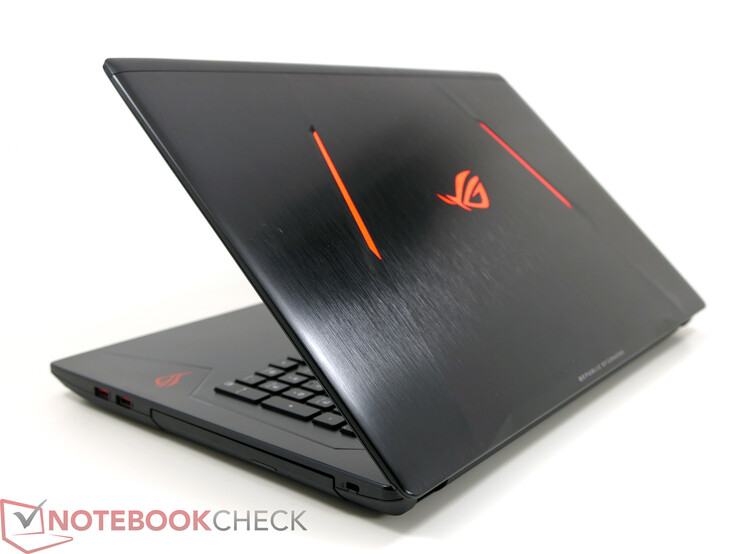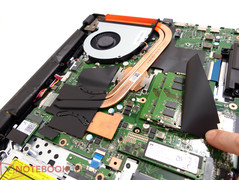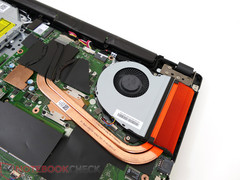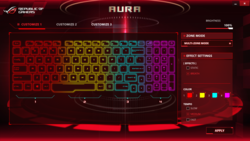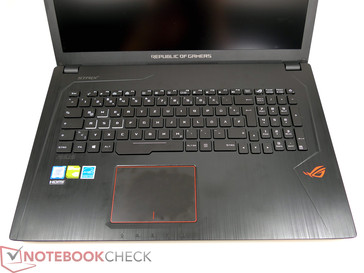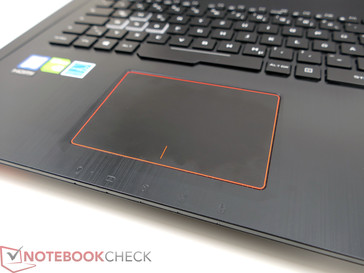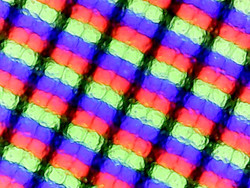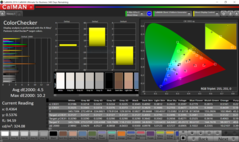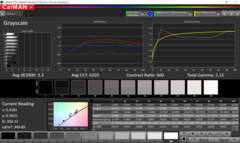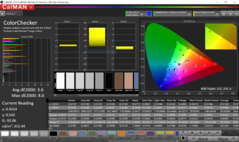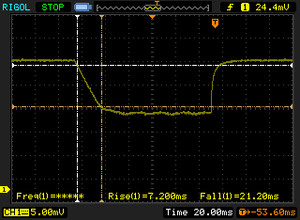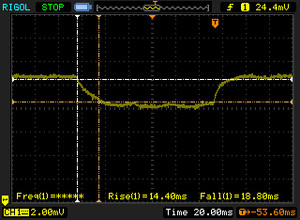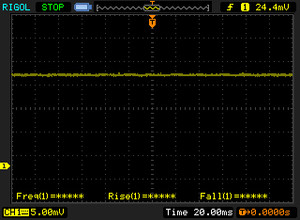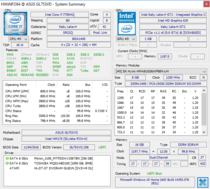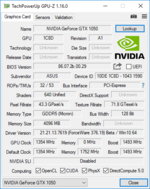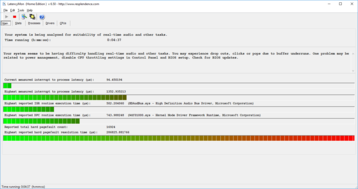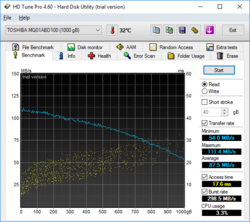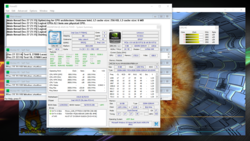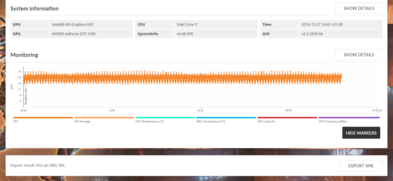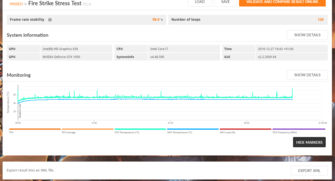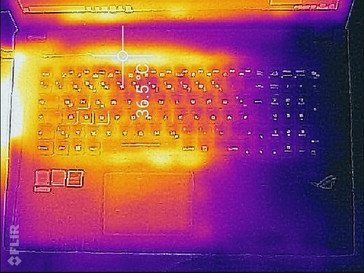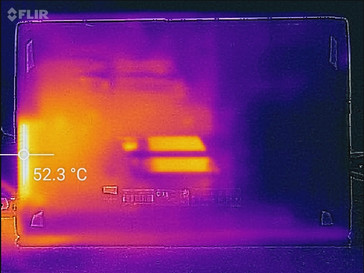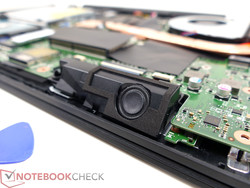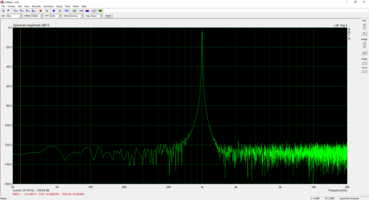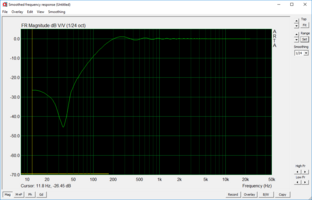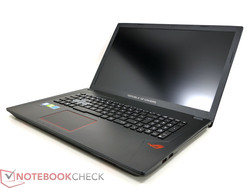Asus ROG Strix GL753VD Notebook Review

For the original German review, see here.
The new Strix GL753VD will complement Asus' mobile gaming portfolio from now on. It is the big brother of the new GL553VD (15-inch), which was also announced, and it represents an entry-level gaming system. The high-end model is still the G752, which can handle smooth frame rates even in 4K or VR thanks to the GeForce GTX 1070 GPU. The GL702 with the GTX 1060 GPU on the other hand is more focused on mobility with its thinner chassis (no optical drive).
Asus charges 1299 Euros (~$1366, RRP) for its new entry-level gaming system with the GeForce GTX 1050 like in our review model. Budget gamers might also want to have a look at the new Asus FX series. It is equipped with similar GPUs but uses a less attractive plastic case and starts at 999 Euros (~$1050).
Asus will not launch models with the new Nvidia GeForce GTX 1050 Ti in Germany for now, but there are supposed to be limited special editions in the future. More details about the faster model of the GeForce GTX 1050 are available in our current review of the MSI GE73 or the preview of the new Acer Aspire VX 15, which will also be available with the GTX 1050 Ti.
We do not have any specific information about more SKUs and their prices yet.
Case
The design of the Asus GL753VD is similar to the previous GL752 and the thinner GL702, respectively. We get a black 17-inch laptop with some orange accents like the ROG logo on the palm rest as well as the lid, and the red surrounding of the touchpad. The cooling fins inside the case as well as the rubber feet at the bottom are colored, too. Turn the system on and the keyboard will be illuminated, just like the ROG logo on the lid. We can only see small differences compared to the predecessor GL752. Similar to the GL702, the GL753 got additional visual elements at the top of the base unit. They create a three-dimensional effect, even though the device itself is completely flat.
Asus uses plastic components for the base unit, while the lid is made of an aluminum plate that was pressed into shape. The stability of the notebook is more than satisfying for a 17-inch system. We could not hear any creaking sounds during our review period. The build quality is decent as well, and we can only notice some uneven gaps in the area around the optical drive.
The Asus ROG Strix GL753VD is pretty average among other gaming notebooks in terms of size and weight. High-end systems like the G752, for example, are much heavier and thicker than the GL753, while systems like the MSI GS73 or the Asus GL702, which put more emphasis on mobility, are even lighter and thinner in particular. This is usually achieved by removing the optical drive.
Connectivity
All the important ports are available on the Asus Strix GL753, but the laptop does not offer any highlights. On the left side are the power connector at the back, and a LAN port, HDMI, mDP, 2x USB 3.0 Type-A as well as one Type-C jack towards the front. The latter, however, does not support any other standards. The headset port is located very far to the front. The SD-card reader sits at the front, but it is hard to see due to the wedge-shaped design.
At the front of the right side are two additional USB ports, but only one of them supports the 3.0 standard, which is only indicated by a tiny symbol. You should therefore watch out when you attach an external hard drive, or the transfer rates will be low. Finally, there is an optical drive and a Kensington lock slot at the right side.
The insufficient labeling of the USB 2.0 port is not the only problem. The location of the ports very far to the front of the sides could be an issue for some users as well. Not only numerous cables could occupy space for left-handers, but peripherals with short cables might also be tricky to use. The 90 cm long cable of the Razer Orochi gaming mouse, for example, is not long enough to be used comfortably. It has to be attached on the right side as a result, which will then affect the range of motion. At least one USB port at the rear of the sides would have been a better solution.
SD-Card Reader
As per usual, we check the performance of the integrated SD-card reader with our Toshiba Exceria Pro SDXC 64 GB UHS-II reference card. The reader manages good results both in the realistic copy test as well as the maximum transfer rate (read). Some devices are equipped with much faster modules, but the GL753 is on par with comparable devices. By the way, the card does not stand out from the slot, so it could stay inside the reader in theory. Ejecting the card was a bit tricky and required using fingernails after the front of the device is lifted.
| SD Card Reader | |
| average JPG Copy Test (av. of 3 runs) | |
| Asus Strix GL753VD-GC045T | |
| Asus GL702VM-GC102D | |
| HP Omen 17-w010ng | |
| MSI GE72 7RE-046 | |
| MSI GE72VR-6RF16H21 | |
| maximum AS SSD Seq Read Test (1GB) | |
| HP Omen 17-w010ng | |
| Asus Strix GL753VD-GC045T | |
| Asus GL702VM-GC102D | |
| MSI GE72 7RE-046 | |
| MSI GE72VR-6RF16H21 | |
Communication
The Wi-Fi performance of the Asus Strix GL753 leaves a very good impression. The laptop manages high transfer rates of up to 666 Mbps in our standardized test, so it can compete with high-end systems. We also increased the distance to our test router and compare the results of the GL753 with the MacBook Pro 13, which performs very well in this regard. Even multiple concrete walls between the router and the test model (distance around 10 meters) do not prevent a connection, and the transfer rates are roughly on par with the MacBook Pro. Well done, Asus.
| Networking | |
| iperf3 transmit AX12 | |
| Apple MacBook Pro Retina 13 inch 2013-10 (Klaus I211) | |
| Asus Strix GL753VD-GC045T | |
| Acer Aspire VX5-591G-D0DD | |
| MSI GE72VR-6RF16H21 | |
| MSI GE72 7RE-046 | |
| iperf3 receive AX12 | |
| Apple MacBook Pro Retina 13 inch 2013-10 (Klaus I211) | |
| Asus Strix GL753VD-GC045T | |
| Acer Aspire VX5-591G-D0DD | |
| MSI GE72 7RE-046 | |
| MSI GE72VR-6RF16H21 | |
Accessories
Asus offers numerous accessories for its ROG gaming notebooks. The lineup includes external input devices like keyboards and mice, headsets, bags, and even cloths, all with a matching design (http://rog.asus.com/).
Maintenance
The GL753 does not have a special maintenance hatch, but it is pretty easy to remove the whole bottom panel with a simple Phillips screwdriver and a sharp object. You must not forget the central screw, which is hidden underneath a sticker. Once the panel is removed, you can access all components and easily replace the M.2-SSD or the 2.5-inch HDD, for example. The two memory slots are accessible as well. Both the fan and the cooling unit can also be removed for cleaning purposes.
Warranty
Asus grants a two-year manufacturer's warranty including a Pick-up & Return service, which is common in Germany. Please see our Guarantees, Return Policies & Warranties FAQ for country-specific information.
Input Devices
Keyboard
The keyboard layout is almost identical to the Asus GL702. It is a chiclet keyboard with an additional numeric keypad on the right side, but the directional keys are a bit separated and enlarged, which is also the case for the left side of the space bar, where you can usually find the thumb when you use the WASD keys. Only two small changes, but they can have a positive effect.
The keys have a well-defined travel (not too short) for a notebook with a satisfying feedback or pressure point, respectively. We can slightly dent the center of the keyboard with a lot of pressure, but this does not affect the typing experience. The noise development during typing is always conveniently muffled and quiet.
Display
The panel type is probably similar to the Asus GL702 as well. It is a matte screen provided by LG-Philips (LP173WF4-SPF3) with a resolution of 1920x1080 pixels. The panel is very bright at up to 349 nits in the center, and the average luminance of the Asus GL753 is not much lower at 337 nits.
The result for the black value is 0.58 cd/m², which is a bit high. The contrast ratio of 602:1 is just sufficient and suffers a bit from the high luminance. Positive: You can also enjoy the maximum brightness on battery power, but the minimum luminance of 20 nits is a bit high.
We can see some backlight bleeding in the lower right area when we watch dark content, but the brightness distribution itself is very good at 91%.
| |||||||||||||||||||||||||
Brightness Distribution: 91 %
Center on Battery: 349 cd/m²
Contrast: 602:1 (Black: 0.58 cd/m²)
ΔE ColorChecker Calman: 4.5 | ∀{0.5-29.43 Ø4.78}
ΔE Greyscale Calman: 3.3 | ∀{0.09-98 Ø5}
75.7% sRGB (Argyll 1.6.3 3D)
55.7% AdobeRGB 1998 (Argyll 1.6.3 3D)
62% AdobeRGB 1998 (Argyll 3D)
84.8% sRGB (Argyll 3D)
67.1% Display P3 (Argyll 3D)
Gamma: 2.15
CCT: 6103 K
| Asus Strix GL753VD-GC045T LP173WF4-SPF3, , 1920x1080, 17.3" | MSI GE72 7RE-046 N173HHE-G32 (CMN1747), , 1920x1080, 17.3" | MSI GS73VR 6RF 1920x1080, 17.3" | Asus G752VS-XB78K LG Philips LP173WF4-SPF3 (LGD04E8), , 1920x1080, 17.3" | Asus GL702VM-GC102D LG Philips LP173WF4-SPF3, , 1920x1080, 17.3" | MSI GE72VR-6RF16H21 N173HHE-G32 (CMN1747), , 1920x1080, 17.3" | HP Omen 17-w010ng AUO119B, , 3840x2160, 17.3" | |
|---|---|---|---|---|---|---|---|
| Display | 30% | 29% | 0% | -2% | 29% | 37% | |
| Display P3 Coverage (%) | 67.1 | 90.7 35% | 90 34% | 66.9 0% | 65.1 -3% | 90.2 34% | 88.5 32% |
| sRGB Coverage (%) | 84.8 | 99.9 18% | 99.9 18% | 85.2 0% | 83.5 -2% | 99.8 18% | 100 18% |
| AdobeRGB 1998 Coverage (%) | 62 | 85.2 37% | 83.6 35% | 62.3 0% | 61.1 -1% | 83.9 35% | 100 61% |
| Response Times | 44% | 42% | 5% | 3% | 44% | -23% | |
| Response Time Grey 50% / Grey 80% * (ms) | 33.2 ? | 27 ? 19% | 28 ? 16% | 38 ? -14% | 38 ? -14% | 28 ? 16% | 49 ? -48% |
| Response Time Black / White * (ms) | 28.8 ? | 9 ? 69% | 9.6 ? 67% | 22 ? 24% | 23 ? 20% | 8 ? 72% | 28 ? 3% |
| PWM Frequency (Hz) | |||||||
| Screen | 0% | 28% | 18% | -16% | 20% | 11% | |
| Brightness middle (cd/m²) | 349 | 253 -28% | 337.2 -3% | 328 -6% | 326 -7% | 270 -23% | 316 -9% |
| Brightness (cd/m²) | 337 | 230 -32% | 315 -7% | 317 -6% | 312 -7% | 254 -25% | 312 -7% |
| Brightness Distribution (%) | 91 | 86 -5% | 86 -5% | 88 -3% | 91 0% | 86 -5% | 90 -1% |
| Black Level * (cd/m²) | 0.58 | 0.24 59% | 0.308 47% | 0.3 48% | 0.5 14% | 0.26 55% | 0.29 50% |
| Contrast (:1) | 602 | 1054 75% | 1095 82% | 1093 82% | 652 8% | 1038 72% | 1090 81% |
| Colorchecker dE 2000 * | 4.5 | 5.01 -11% | 2.96 34% | 3.74 17% | 6.3 -40% | 3.33 26% | 5.69 -26% |
| Colorchecker dE 2000 max. * | 10.2 | 10.4 -2% | 5.45 47% | 8.97 12% | 11.69 -15% | 6.07 40% | 7.94 22% |
| Greyscale dE 2000 * | 3.3 | 7.26 -120% | 2.57 22% | 2.67 19% | 7.37 -123% | 3.46 -5% | 6.12 -85% |
| Gamma | 2.15 102% | 2.09 105% | 2.25 98% | 2.41 91% | 2.37 93% | 2.13 103% | 2.56 86% |
| CCT | 6103 107% | 6329 103% | 7114 91% | 6861 95% | 7116 91% | 7419 88% | 5875 111% |
| Color Space (Percent of AdobeRGB 1998) (%) | 55.7 | 76 36% | 74.3 33% | 56 1% | 55 -1% | 75 35% | 87 56% |
| Color Space (Percent of sRGB) (%) | 75.7 | 100 32% | 100 32% | 85 12% | 83 10% | 100 32% | 100 32% |
| Total Average (Program / Settings) | 25% /
12% | 33% /
30% | 8% /
12% | -5% /
-11% | 31% /
25% | 8% /
12% |
* ... smaller is better
A comparison with other gaming notebooks shows that the Asus Strix GL753 primarily stands out with the high panel luminance, while the black value and the contrast, respectively, fall behind the competition. The color accuracy of the display is acceptable ex-works, but the grayscale in particular can really benefit from a calibration. Our icc.-file is linked in the box above.
The determined response times are rather long at 33.2 ms black-to-white and 28.8 ms gray-to-gray. Systems with fast 120 Hz panels have a clear advantage in this respect. Asus does not use PWM, so even dimmed brightness levels should not be a problem for sensitive users. Nvidia's G-Sync is not supported.
Display Response Times
| ↔ Response Time Black to White | ||
|---|---|---|
| 28.8 ms ... rise ↗ and fall ↘ combined | ↗ 7.6 ms rise | |
| ↘ 21.2 ms fall | ||
| The screen shows relatively slow response rates in our tests and may be too slow for gamers. In comparison, all tested devices range from 0.1 (minimum) to 240 (maximum) ms. » 75 % of all devices are better. This means that the measured response time is worse than the average of all tested devices (20.2 ms). | ||
| ↔ Response Time 50% Grey to 80% Grey | ||
| 33.2 ms ... rise ↗ and fall ↘ combined | ↗ 14.4 ms rise | |
| ↘ 18.8 ms fall | ||
| The screen shows slow response rates in our tests and will be unsatisfactory for gamers. In comparison, all tested devices range from 0.165 (minimum) to 636 (maximum) ms. » 44 % of all devices are better. This means that the measured response time is similar to the average of all tested devices (31.6 ms). | ||
Screen Flickering / PWM (Pulse-Width Modulation)
| Screen flickering / PWM not detected | |||
In comparison: 53 % of all tested devices do not use PWM to dim the display. If PWM was detected, an average of 8111 (minimum: 5 - maximum: 343500) Hz was measured. | |||
Performance
We can find brand-new components inside the Asus Strix GL753. The processor is one of the first new Intel Core i7-7700HQ chips, a quad-core CPU based on the latest Kaby Lake generation. Graphics are handled by the new Nvidia GeForce GTX 1050 graphics card.
The remaining specs of our Asus Strix GL753VD include 16 GB memory provided by two 8 GB modules. The storage solution consists of a 256 GB SSD as well as a 1 TB hard drive. We expect that Asus will offer SKUs with different memory and storage configurations, but we have no specific information at the time of writing.
Processor
The Core i7-7700HQ (Kaby Lake) is the successor to the i7-6700HQ (Skylake), a mobile quad-core CPU, which runs in many gaming and powerful multimedia notebooks. The chip is now manufactured in a 14 nm process and has a TDP of 45 Watts with a clock range of 2.8-3.8 GHz.
Let's have a look at the CPU benchmarks: The Strix GL753 scores 151 points in the Cinebench R15 Single-Core Test, which is about 4-11% faster than devices with the previous i7-6700HQ, while we can see an advantage of 8-9% in the Multi Test. This is roughly on par with the improvements we saw with the previous change of CPU generations. Overall, the chip is a bit faster, but it is not necessary to upgrade, especially since gaming notebooks are still limited by the graphics performance.
More information about the new Intel Kaby Lake quad-core processor generation with numerous benchmarks and analysis is available in our dedicated article.
System Performance
We can give the Asus Strix GL753VD a good rating in terms of system performance thanks to the components, the benchmark results, and our subjective impression during the review period. Our test model is a very good foundation for any kind of multimedia application, all the way up to smooth gameplay in modern titles.
| PCMark 8 - Home Score Accelerated v2 | |
| Asus G752VS-XB78K | |
| Asus GL702VM-GC102D | |
| Asus Strix GL753VD-GC045T | |
| MSI GS73VR 6RF | |
| MSI GE72VR-6RF16H21 | |
| Acer Aspire VX5-591G-D0DD | |
| HP Omen 17-w010ng | |
| PCMark 8 Home Score Accelerated v2 | 4088 points | |
| PCMark 10 Score | 3724 points | |
Help | ||
Storage Devices
Asus equips our test model with a combination of SSD (256 GB Micron MTFDDAV256TBN) as well as conventional HDD storage (1 TB Toshiba MQ01ABD100). The exact configuration can vary depending on the model. The performance of the Micron SSD is inconspicuous compared to other SATA-III drives. NVMe-SSDs are much faster in the benchmarks, but this does not really result in a perceptible advantage in practice. The capacity of 256 GB is sufficient for some system files as well as some frequently played games, and the drive ensures quick loading times of applications.
| Asus Strix GL753VD-GC045T Micron SSD 1100 (MTFDDAV256TBN) | MSI GE72 7RE-046 Toshiba HG6 THNSNJ256G8NY | MSI GS73VR 6RF SanDisk SD8SN8U1T001122 | Asus G752VS-XB78K Toshiba NVMe THNSN5512GPU7 | HP Omen 17-w010ng Samsung PM951 NVMe MZVLV512 | |
|---|---|---|---|---|---|
| CrystalDiskMark 3.0 | 23% | -25% | 198% | 81% | |
| Read Seq (MB/s) | 475.7 | 540 14% | 334.3 -30% | 1718 261% | 1234 159% |
| Write Seq (MB/s) | 419.1 | 495.7 18% | 319 -24% | 1305 211% | 583 39% |
| Read 512 (MB/s) | 336.1 | 455.1 35% | 242.3 -28% | 1250 272% | 606 80% |
| Write 512 (MB/s) | 346.6 | 481.4 39% | 254.4 -27% | 1438 315% | 428.3 24% |
| Read 4k (MB/s) | 24.7 | 22.7 -8% | 20.3 -18% | 44.42 80% | 41.42 68% |
| Write 4k (MB/s) | 76.8 | 112.9 47% | 42.51 -45% | 154.4 101% | 137.2 79% |
| Read 4k QD32 (MB/s) | 247.6 | 372.5 50% | 251.6 2% | 744 200% | 622 151% |
| Write 4k QD32 (MB/s) | 234.9 | 212.9 -9% | 167.1 -29% | 578 146% | 348.3 48% |
GPU Performance
The GeForce GTX 1050 is the successor to the GTX 960M and will therefore be mainly found inside multimedia notebooks. The 3DMark benchmarks show an advantage of around 30% for the GTX 1050 compared to the old GTX 960M and is roughly on par with the GTX 965M, which already bridged the gap between multimedia and gaming. The next faster model, the GeForce GTX 1050 Ti, as well as the older GTX 970M, is clearly ahead with an advantage of around 30%. It is once again impressive to see the performance of Nvidia's high-end chips: The GeForce GTX 1060, which is the "entry-level GPU" for full-fledged gaming notebooks, is almost twice as fast as the GTX 1050.
| 3DMark 11 - 1280x720 Performance GPU | |
| Asus GL702VM-GC102D | |
| MSI GE72 7RE-046 | |
| Asus Strix GL502VT-DS74 | |
| Acer Aspire VX5-591G-D0DD | |
| HP Omen 17-w010ng | |
| Asus Strix GL753VD-GC045T | |
| Asus GL752VW-T4168T | |
| Asus N752VX-GC131T | |
| 3DMark 06 Standard Score | 27411 points | |
| 3DMark 11 Performance | 7524 points | |
| 3DMark Cloud Gate Standard Score | 19688 points | |
| 3DMark Fire Strike Score | 4965 points | |
| 3DMark Fire Strike Extreme Score | 2444 points | |
| 3DMark Time Spy Score | 1665 points | |
Help | ||
Gaming Performance
This brings us to one of the most interesting sections, the actual gaming performance. How does the GTX 1050 really perform compared to the old GTX 960?
We performed benchmark tests for a couple of games and can see that the majority of modern titles run smoothly in Full HD and the High preset. The performance advantage over the GTX 960M can be as high as 30% depending on the game, sometimes even more. The GTX 1050 is therefore roughly on the level of the older GTX 965M. The new GeForce GTX 1050 Ti is another 30% ahead of the standard GTX 1050 and is roughly on par with the GTX 970M.
One thing we noticed in our tests was the sometimes inconsistent performance with low GPU load (low, med details). This might be a result of the GPU driver (376.19), which is not yet finalized. It is also possible that some games will perform even better with an improved driver version.
| The Witcher 3 | |
| 1920x1080 High Graphics & Postprocessing (Nvidia HairWorks Off) | |
| MSI GE72 7RE-046 | |
| Schenker W504 | |
| Acer Aspire VX5-591G-D0DD | |
| MSI GE72 965M Ti | |
| Asus Strix GL753VD-GC045T | |
| Schenker XMG A505 | |
| 1920x1080 Ultra Graphics & Postprocessing (HBAO+) | |
| MSI GE72 7RE-046 | |
| Schenker W504 | |
| Acer Aspire VX5-591G-D0DD | |
| MSI GE72 965M Ti | |
| Asus Strix GL753VD-GC045T | |
| Schenker XMG A505 | |
| World of Warships | |
| 1920x1080 High Preset AF:8x | |
| Asus Strix GL753VD-GC045T | |
| Acer Aspire VX5-591G-D0DD | |
| MSI GE72 965M Ti | |
| 1920x1080 Very High Preset AA:High FX AF:16x | |
| Acer Aspire VX5-591G-D0DD | |
| Asus Strix GL753VD-GC045T | |
| MSI GE72 965M Ti | |
| Fallout 4 | |
| 1920x1080 High Preset AA:T AF:16x | |
| MSI GE72 7RE-046 | |
| Acer Aspire VX5-591G-D0DD | |
| Schenker W504 | |
| MSI GE72 965M Ti | |
| Asus Strix GL753VD-GC045T | |
| Schenker XMG A505 | |
| 1920x1080 Ultra Preset AA:T AF:16x | |
| MSI GE72 7RE-046 | |
| Acer Aspire VX5-591G-D0DD | |
| Schenker W504 | |
| MSI GE72 965M Ti | |
| Asus Strix GL753VD-GC045T | |
| Schenker XMG A505 | |
| Rise of the Tomb Raider | |
| 1920x1080 High Preset AA:FX AF:4x | |
| MSI GE72 7RE-046 | |
| Acer Aspire VX5-591G-D0DD | |
| Schenker W504 | |
| MSI GE72 965M Ti | |
| Asus Strix GL753VD-GC045T | |
| Schenker XMG A505 | |
| 1920x1080 Very High Preset AA:FX AF:16x | |
| MSI GE72 7RE-046 | |
| Acer Aspire VX5-591G-D0DD | |
| Schenker W504 | |
| Asus Strix GL753VD-GC045T | |
| MSI GE72 965M Ti | |
| Schenker XMG A505 | |
| FIFA 17 | |
| 1920x1080 High Preset | |
| Asus GL702VM-GC102D | |
| Schenker W504 | |
| Asus Strix GL753VD-GC045T | |
| MSI GE72 7RE-046 | |
| Schenker XMG A505 | |
| Acer Aspire VX5-591G-D0DD | |
| 1920x1080 Ultra Preset AA:4xMS | |
| Asus GL702VM-GC102D | |
| Schenker W504 | |
| MSI GE72 965M Ti | |
| Asus Strix GL753VD-GC045T | |
| MSI GE72 7RE-046 | |
| Acer Aspire VX5-591G-D0DD | |
| Schenker XMG A505 | |
| Battlefield 1 | |
| 1920x1080 High Preset AA:T | |
| Asus GL702VM-GC102D | |
| Schenker W504 | |
| MSI GE72 7RE-046 | |
| Acer Aspire VX5-591G-D0DD | |
| MSI GE72 965M Ti | |
| Asus Strix GL753VD-GC045T | |
| Schenker XMG A505 | |
| 1920x1080 Ultra Preset AA:T | |
| Asus GL702VM-GC102D | |
| Schenker W504 | |
| MSI GE72 7RE-046 | |
| Acer Aspire VX5-591G-D0DD | |
| MSI GE72 965M Ti | |
| Asus Strix GL753VD-GC045T | |
| Schenker XMG A505 | |
| Titanfall 2 | |
| 1920x1080 High / Enabled AA:TS AF:8x | |
| Asus GL702VM-GC102D | |
| Acer Aspire VX5-591G-D0DD | |
| MSI GE72 7RE-046 | |
| Asus Strix GL753VD-GC045T | |
| Schenker W504 | |
| MSI GE72 965M Ti | |
| Schenker XMG A505 | |
| 1920x1080 Very High (Insane Texture Quality) / Enabled AA:TS AF:16x | |
| Asus GL702VM-GC102D | |
| Acer Aspire VX5-591G-D0DD | |
| Asus Strix GL753VD-GC045T | |
| MSI GE72 7RE-046 | |
| Schenker W504 | |
| MSI GE72 965M Ti | |
| Schenker XMG A505 | |
| low | med. | high | ultra | 4K | |
|---|---|---|---|---|---|
| Metro: Last Light (2013) | 74 | 40 | |||
| Sims 4 (2014) | 73 | ||||
| The Witcher 3 (2015) | 112.3 | 66.9 | 29.1 | 19.7 | |
| Dota 2 Reborn (2015) | 154 | 143 | 126 | 117 | |
| World of Warships (2015) | 154 | 131 | 109 | 79 | |
| Anno 2205 (2015) | 113 | 92 | 43.7 | 13.9 | |
| Fallout 4 (2015) | 116.6 | 74.6 | 41.2 | 33.9 | |
| Rainbow Six Siege (2015) | 209 | 133 | 71 | 58 | |
| Rise of the Tomb Raider (2016) | 110.1 | 63.2 | 37.1 | 31.2 | |
| XCOM 2 (2016) | 94 | 44.6 | 27.4 | 13.6 | |
| Far Cry Primal (2016) | 99 | 47 | 41 | 30 | |
| The Division (2016) | 70 | 33.2 | 25.4 | ||
| Ashes of the Singularity (2016) | 32.4 | 28.6 | |||
| Doom (2016) | 51.7 | 48.2 | 16.2 | ||
| Overwatch (2016) | 90 | 53.8 | 27.9 | ||
| Deus Ex Mankind Divided (2016) | 71.7 | 53.6 | 29.6 | 15.3 | |
| FIFA 17 (2016) | 224 | 199 | 144 | 131 | |
| Mafia 3 (2016) | 52.7 | 34.4 | 22 | ||
| Battlefield 1 (2016) | 145.6 | 101.7 | 46.5 | 41.1 | |
| Civilization 6 (2016) | 73 | 60.2 | 39.4 | 31.7 | |
| Farming Simulator 17 (2016) | 74 | 37 () | |||
| Titanfall 2 (2016) | 130.6 | 81.5 | 60.7 | 61 | |
| Call of Duty Infinite Warfare (2016) | 99 | 89 | 51.1 | 46.2 | 19.1 |
| Dishonored 2 (2016) | 76 | 66 | 37.4 | 32.7 | |
| Watch Dogs 2 (2016) | 72 | 61.2 | 32 | 19.8 | |
| Warhammer 40.000: Dawn of War III (2017) | 106 | 33.6 | 22.2 | 18.8 | |
| Team Fortress 2 (2017) | 117 | 111 | 61.5 | ||
| Playerunknown's Battlegrounds (PUBG) (2017) | 87 | 39.6 | 34.5 | 24.2 | |
| F1 2017 (2017) | 133 | 67 | 52 | 33 |
Emissions
System Noise
The fan of the GL753 was never deactivated on our test model, but the dull and sonorous murmur is not a big issue. The fact that the fan speed often fluctuates even with office workloads is more annoying, because you can clearly hear the rpm increases and decreases, respectively. A more conservative fan control for peak load situations in office scenarios would have been possible when you consider the comparatively cool hardware temperatures.
The system will get louder under sustained gaming workloads. It depends a lot on the hardware requirements of the game. We can measure values between 42.7 dB(A) and 47.4 dB(A), although the latter is already very loud when you consider the mainstream GPU performance. Still, the noise characteristics stay unobtrusive, and we did not hear any kind of electronic noises.
Noise level
| Idle |
| 33.9 / 33.9 / 37.8 dB(A) |
| Load |
| 42.7 / 47.4 dB(A) |
 | ||
30 dB silent 40 dB(A) audible 50 dB(A) loud |
||
min: | ||
Stress Test
We stress the Asus ROG Strix GL753 with the tools FurMark and Prime95 and observe the clocks as well as the temperatures over a longer period. As expected, the large chassis, which is equipped with just one fan and two heat pipes, does not seem to have a problem keeping the components cool. The CPU does not drop below its nominal clock and can still utilize a part of its Turbo potential at 3 GHz. The GPU on the other hand only runs at around 640 MHz, which is clearly below the maximum value of 1354 MHz. We saw a CPU temperature of around 85 °C and 71 °C for the GPU during the stress test.
The Asus GL753 also performs well in the 3DMark stress test. The CPU temperature levels off at around 55 °C under realistic 3D scenarios, and the GPU only warms up to 50 °C. The logged frame rate is steady over the whole course of the test (more than one hour), which is not really surprising when you consider the low core temperatures.
Temperature
Not only the components of the laptop stay comparatively cool while idling, this is also the case for the surfaces you come into contact with. The whole chassis of the Strix GL753 only warms up to values slightly above room temperature.
If you really stress the notebook for longer periods (stress test), you can feel that the surfaces warm up, but it is almost negligible at up to 37.7 °C. Attention: The marker on the following infrared picture of the bottom (52.3 °C) is targeted at the cooling fins inside the chassis!
(+) The maximum temperature on the upper side is 37.7 °C / 100 F, compared to the average of 40.4 °C / 105 F, ranging from 21.2 to 68.8 °C for the class Gaming.
(+) The bottom heats up to a maximum of 36.3 °C / 97 F, compared to the average of 43.3 °C / 110 F
(+) In idle usage, the average temperature for the upper side is 24.1 °C / 75 F, compared to the device average of 33.9 °C / 93 F.
(+) The palmrests and touchpad are reaching skin temperature as a maximum (32.3 °C / 90.1 F) and are therefore not hot.
(-) The average temperature of the palmrest area of similar devices was 28.9 °C / 84 F (-3.4 °C / -6.1 F).
Speakers
The stereo speakers at the front edge of the laptop provide a satisfying sound for audio and video playback as well as gaming. The maximum volume of around 80 dB(A) is sufficient for a smaller room, but it will not be enough for a party.
A frequency comparison with the compact MacBook 12, which can still be seen as the reference in terms of audio, shows that the Asus primarily lacks bass and high tones, which prevents an excellent result.
Asus Strix GL753VD-GC045T audio analysis
(±) | speaker loudness is average but good (81.5 dB)
Bass 100 - 315 Hz
(-) | nearly no bass - on average 15.8% lower than median
(±) | linearity of bass is average (12.2% delta to prev. frequency)
Mids 400 - 2000 Hz
(+) | balanced mids - only 3.1% away from median
(±) | linearity of mids is average (7% delta to prev. frequency)
Highs 2 - 16 kHz
(±) | higher highs - on average 6.3% higher than median
(+) | highs are linear (5.4% delta to prev. frequency)
Overall 100 - 16.000 Hz
(±) | linearity of overall sound is average (17.2% difference to median)
Compared to same class
» 46% of all tested devices in this class were better, 11% similar, 42% worse
» The best had a delta of 6%, average was 18%, worst was 132%
Compared to all devices tested
» 31% of all tested devices were better, 8% similar, 61% worse
» The best had a delta of 4%, average was 24%, worst was 134%
Apple MacBook 12 (Early 2016) 1.1 GHz audio analysis
(+) | speakers can play relatively loud (83.6 dB)
Bass 100 - 315 Hz
(±) | reduced bass - on average 11.3% lower than median
(±) | linearity of bass is average (14.2% delta to prev. frequency)
Mids 400 - 2000 Hz
(+) | balanced mids - only 2.4% away from median
(+) | mids are linear (5.5% delta to prev. frequency)
Highs 2 - 16 kHz
(+) | balanced highs - only 2% away from median
(+) | highs are linear (4.5% delta to prev. frequency)
Overall 100 - 16.000 Hz
(+) | overall sound is linear (10.2% difference to median)
Compared to same class
» 7% of all tested devices in this class were better, 2% similar, 91% worse
» The best had a delta of 5%, average was 18%, worst was 53%
Compared to all devices tested
» 4% of all tested devices were better, 1% similar, 94% worse
» The best had a delta of 4%, average was 24%, worst was 134%
Frequency comparison (checkboxes can be selected)
The integrated headset port showed very good results in the 1 KHz Sinus test. THD, THD+N and SNR results were very good. However, in the sinus sweep across all frequencies we see an interested fall-off below 200 Hz. Maybe some software settings out of the box in our unit are to blame.
Energy Management
Power Consumption
Nvidia's Optimus technology is supported, so the GL753 can use the integrated HD Graphics 630 from the processor with simple workloads and the power consumption even drops below 10 Watts while idling. For comparison: The values in our measurements are slightly below the HP Pavilion 17, which is equipped with the GTX 960M GPU and Intel i7-6700HQ CPU, the respective predecessors. This is a very good result when you consider the performance increases of around 10% for the CPU and sometimes more than 30% for the GPU.
| Off / Standby | |
| Idle | |
| Load |
|
Key:
min: | |
| Asus Strix GL753VD-GC045T i7-7700HQ, GeForce GTX 1050 Mobile, Micron SSD 1100 (MTFDDAV256TBN), LED IPS, 1920x1080, 17.3" | HP Pavilion 17 FHD V3A33AV 6700HQ, GeForce GTX 960M, SanDisk Z400s SD8SNAT-128G, IPS, 1920x1080, 17.3" | MSI GE72 7RE-046 i7-7700HQ, GeForce GTX 1050 Ti Mobile, Toshiba HG6 THNSNJ256G8NY, TN LED, 1920x1080, 17.3" | Asus GL702VM-GC102D 6700HQ, GeForce GTX 1060 Mobile, HGST Travelstar 7K1000 HTS721010A9E630, IPS, 1920x1080, 17.3" | Asus G752VS-XB78K 6820HK, GeForce GTX 1070 Mobile, Toshiba NVMe THNSN5512GPU7, IPS, 1920x1080, 17.3" | |
|---|---|---|---|---|---|
| Power Consumption | 13% | -54% | -58% | -133% | |
| Idle Minimum * (Watt) | 6.2 | 5.3 15% | 14 -126% | 15.6 -152% | 24 -287% |
| Idle Average * (Watt) | 12.2 | 10.6 13% | 20 -64% | 20.2 -66% | 31 -154% |
| Idle Maximum * (Watt) | 14.8 | 11.8 20% | 25 -69% | 21.4 -45% | 36 -143% |
| Load Average * (Watt) | 84.9 | 70.9 16% | 82 3% | 90 -6% | 94 -11% |
| Load Maximum * (Watt) | 120.7 | 119.8 1% | 135 -12% | 147 -22% | 204 -69% |
* ... smaller is better
Battery Runtime
The majority of gaming notebooks cannot convince with long battery runtimes. Little more than four hours in the realistic Wi-Fi test is actually not a bad result for the GL753. However, you should not expect the full gaming performance of the system on battery power, because the GL753 can only utilize a fraction of its potential (CPU!) without a socket.
| Asus Strix GL753VD-GC045T i7-7700HQ, GeForce GTX 1050 Mobile, 48 Wh | HP Pavilion 17 FHD V3A33AV 6700HQ, GeForce GTX 960M, 62 Wh | HP Omen 17-w010ng 6700HQ, GeForce GTX 965M, 62 Wh | MSI GE72 7RE-046 i7-7700HQ, GeForce GTX 1050 Ti Mobile, 51.4 Wh | Asus GL702VM-GC102D 6700HQ, GeForce GTX 1060 Mobile, 76 Wh | Asus G752VS-XB78K 6820HK, GeForce GTX 1070 Mobile, 90 Wh | |
|---|---|---|---|---|---|---|
| Battery runtime | 64% | 13% | -30% | 17% | 5% | |
| Reader / Idle (h) | 8.6 | 12.5 45% | 7.3 -15% | 5.9 -31% | 5.2 -40% | |
| WiFi v1.3 (h) | 4.4 | 5.9 34% | 4 -9% | 3.1 -30% | 4.2 -5% | 3.5 -20% |
| Load (h) | 0.8 | 1.7 113% | 1.3 63% | 1.5 88% | 1.4 75% | |
| H.264 (h) | 3.6 | 3.3 | 4.4 | 3.1 |
Pros
Cons
Verdict
We want to summarize our observations: The Asus ROG GL753VD comes in a passably styled and not too flashy chassis with good stability and build quality. The port selection is satisfying, but there are no highlights and the layout at the front of the sides is not perfect, either. The Wi-Fi performance is exemplary and the transfer rates of the SD-card reader are okay. Another positive aspect is that users get access to the storage devices and the memory slots (although you need a screwdriver). Asus improved the input devices a bit compared to the GL702. The display is familiar and very bright; contrast and the colors are just okay. Positive: Asus does not use PWM, but the display cannot keep up with fast 120 Hz panels in terms of response times.
The performance is a bit more interesting: The combination of Intel i7-7700HQ quad-core CPU and Nvidia GeForce GTX 1050 GPU usually manages smooth frame rates in most modern games in the native Full HD resolution and high settings. The GTX 960M is beaten by around 30%, but the new GTX 1060 is still up to twice as fast. The GTX 1050 Ti is about 30% faster than the regular GTX 1050. It will ultimately depend on the price of gaming notebooks with the GTX 1050, GTX 1050 Ti, and GTX 1060. The Asus ROG Strix GL502VM and other similarly equipped systems already start at around 1,300 Euros (~$1367) and promise much more gaming performance with a combination of i7-6700HQ CPU and GTX 1060 GPU.
The remaining scoring criteria of the GL753 are just as inconspicuous. The system is always cool, but the fan is almost too loud under loud and there is room for improvement while idling as well. The sound quality is okay, just like the battery runtime, even though 4-5 hours in practice is hardly impressive.
The success of the GL753 will mainly depend on the pricing, because you can get much more gaming performance for 1,300 Euros (~$1367). The Strix GL753 should be considerably more affordable when it hits retail shelves.
Asus Strix GL753VD-GC045T
- 12/29/2016 v6 (old)
J. Simon Leitner




